How to Bail on a Sport Climb with a Biner (2024 Guide)
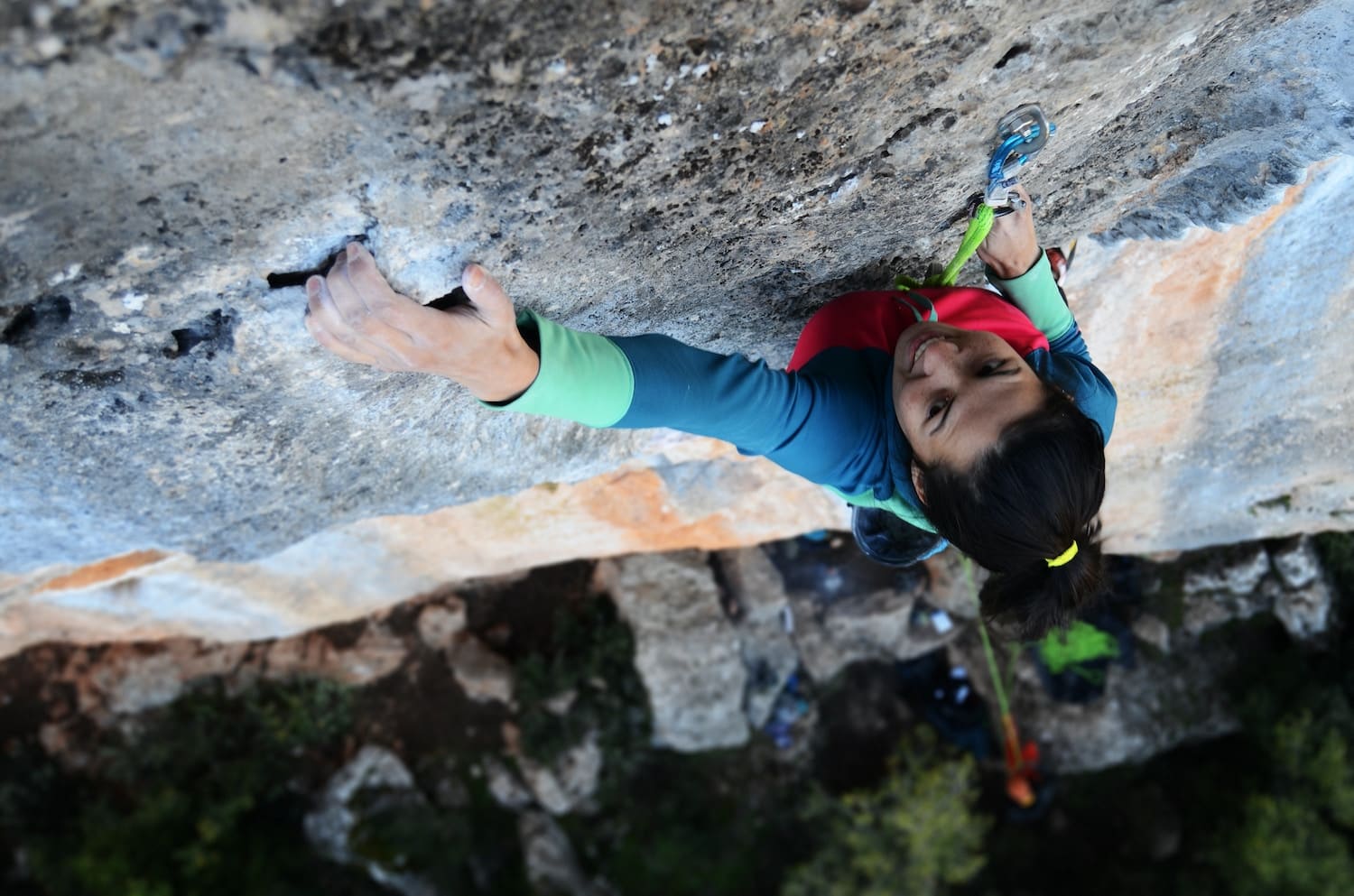
Published on: 03/27/2023
If you have been sport climbing long enough, you’ve probably reached a point where you could not finish the climb you were trying. Maybe the crux was too hard, or maybe you were pumped out of your brains and couldn’t hold anything. Or maybe the short weather window you were enjoying has closed, and a rainstorm has begun to soak you and the route.
Sometimes you can send your rope-gun friend to finish the climb and rescue the gear. But what if bailing and going down is the only solution? How would you lower and clean the route without reaching the anchors first? The answer is with a bail biner.
Bailing on a sport climb is not a prideful moment. But it’s a necessary tool to have in your toolbox–just in case. Read on to learn how to bail using a bail carabiner.
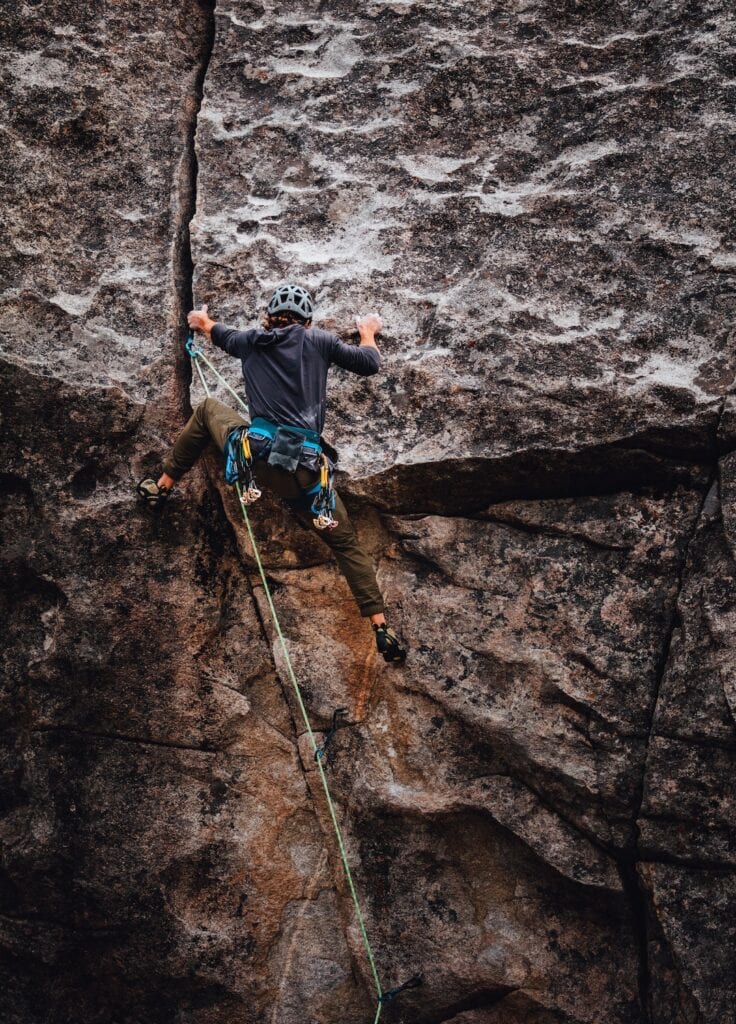
What does “Bailing” Mean in Climbing?
Bailing from a climb means prematurely going down before finishing the route. Depending on the context, bailing can look different.
This article discusses using a carabiner to bail on a sport route before reaching the anchors. Compared to other scenarios, like bailing on a trad multi-pitch route, bailing on a sport climb is relatively simple.
But before I discuss the skill of using a bail biner to lower off a sport climb, it’s crucial to make a few points very clear.
Considerations When Abandoning a Sport Route
First and foremost, bailing requires you to lower off a single bolt. It is not a redundant system like a standard sport anchor. Therefore, if the bolt or bolt hanger looks suspicious, do not use it to bail.
Second, if done improperly, or if the top bolt you are using fails, bailing can result in a large fall with potentially severe consequences. Therefore, bailing on a sport route should be seen as the worst-case scenario.
Before deciding to bail, ask yourself a few questions.
- Do I have the necessary knowledge and equipment to do this safely?
- Can someone else at the crag finish the route for me and rescue the gear?
- Can I rest longer and pass the crux sequence to the next bolt?
- Can I use a stick clip to clip the next bolt and advance past the crux?
- Can I leave my quickdraw and come back for it another time?
If, after considering these options, bailing using a carabiner seems like your only choice, remember to avoid the following.

Problems with Lowering from a Carabiner: The Dos and Don’ts
As we said above, bailing on a route is not an ideal scenario. It’s not the end of the world– but it should be avoided.
The main reason is that it forces you to lower off a single piece of protection. Yes, it is true that if you’re bailing, you’ve probably already fallen and hung on the bolt many times. In which case, it may be safe to assume that it can handle lowering you to the ground.
Nonetheless, having redundancy in climbing is preferred, which is why lowering from the anchors is the typical way to get a person down.
Bailing also requires you to abandon equipment on one bolt. In this case, the bail carabiner becomes fair game for the next climber who wants to try the route. That’s why most of us would agree that leaving behind an old carabiner is better than a quickdraw.
Leaving behind gear is annoying, but sometimes you must make tough choices. So if you are considering being lowered before reaching the anchors, remember the following do’s and don’ts.
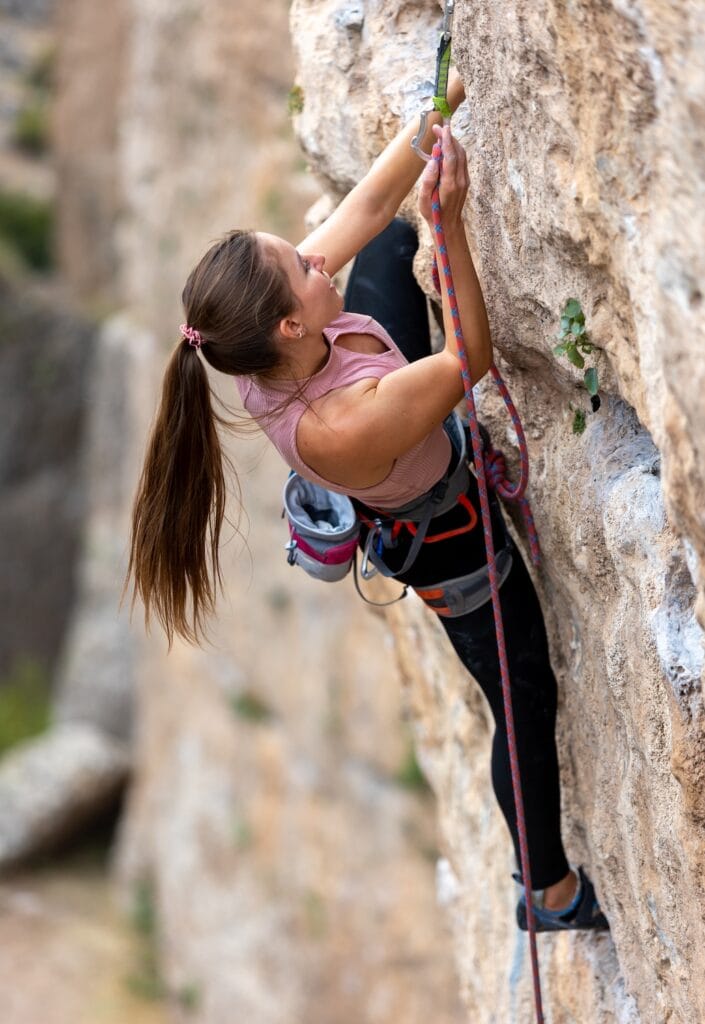
Do’s
- Be very clear that your belayer is to lower you and is not to take you off belay until your feet touch the ground.
- Inspect the hardware and the rock around the bolt to ensure it suits your safety standards.
- Use a personal carabiner to bail instead of using a quicklink. You can use a locking carabiner for added security.
- Use a functioning friction hitch attached to the climbing rope to decrease the distance you’ll fall if your single bolt fails.
Don’ts
- Do not bail with quicklinks– they can rust shut. After they rust shut, they are difficult to remove. Therefore, using a quicklink is bad form.
- Do not bail by threading your rope directly through the bolt hanger to rappel or lower. Most bolt hangers on sport climbs are not designed to accommodate a climbing rope.
- Do not use soft goods, i.e., webbing or a sling, to bail with instead of carabiners. The friction your rope generates while lowering, and perhaps from rappelling, can melt the material and cause catastrophic failure. (1)
- If the bolt or hanger is rusted, spinning, or damaged, or if it’s not properly drilled into the rock, do not bail using that hardware.

How to Safely Bail from a Sport Route
Using a carabiner to bail from a sport climb is relatively simple. It involves replacing the quickdraw you have attached to the highest bolt with a different biner you don’t mind leaving behind, then lowering and cleaning the route like normal.
The following steps explain one way to bail as recommended by Petzl (2).
- Go “in-direct” to the bolt by attaching yourself directly with another quickdraw or tethering tool– the shorter, the better. Go in-direct into the top carabiner of your quickdraw instead of the bolt hanger to save space for the next step.
- Clip a bail carabiner into the bolt hanger underneath the quickdraw you are attached to. Use a locker for added security. Depending on the steepness of the terrain and your ability to pull up and shift your body weight, clipping underneath may be difficult. Note: Petzl recommends to use a quick link, but as mentioned above, they can rust and be difficult to open for the next climbers.
- Ask your belay for “slack.” Using the slack, clip the rope into your bail carabiner and unclip it from your last draw.
- Ask your belayer to “take” so you can hang on the bail biner and remove the last quickdraw and your tether.
- Before lowering, attach a functioning friction hitch, like a prusik (3), to the climbing rope and clip it to your belay loop with a locker. If the bolt or rock fails, the distance you fall will be shortened because you’ll fall onto the prusik and eliminate the loop of slack created from the bolt failure.
- Ask your belayer to “lower” and clean the rest of the quickdraws like normal on your way to the ground, sliding the prusik down with your hand.
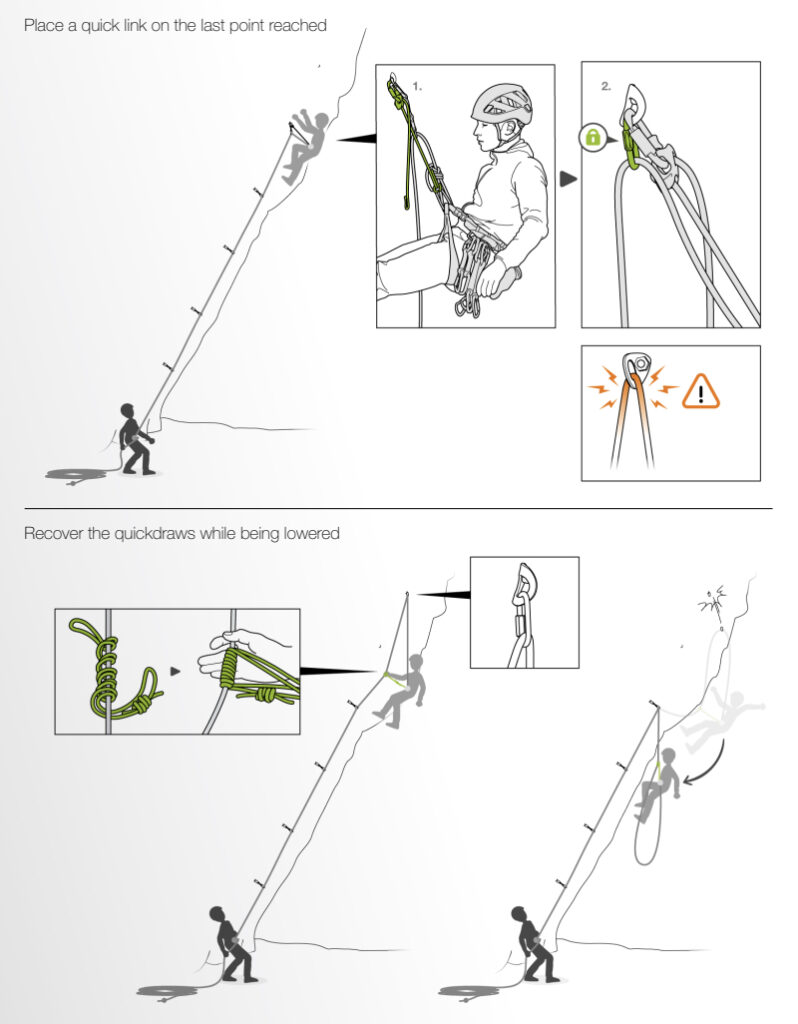
Alternate Methods for Getting Down
If you need to bail on a climb, using a bail biner is not the only method for getting down.
The simplest and safest is to cut your losses and get lowered by your belayer, leaving the draws. Then, a different person can try to send the climb and rescue the gear.
Or, if the route is next to an easier climb, you can lower and clean the draws below you and climb the easier route instead. Then grab the draw you left behind on your way down from the easier route.
Using a Stick Clip to Bail Upwards
If you don’t want to bail down, you can bail up instead by using a stick clip. This involves using a stick to clip the next draw. Then, you can reach the next section with a top rope. If needed, you can use the rope and your belayer for assistance.
Then, you can repeat the technique to clip more bolts. Or, if you’ve passed the unclimbable section, you can finish the route on lead and clean your gear like usual once you reach the anchors.
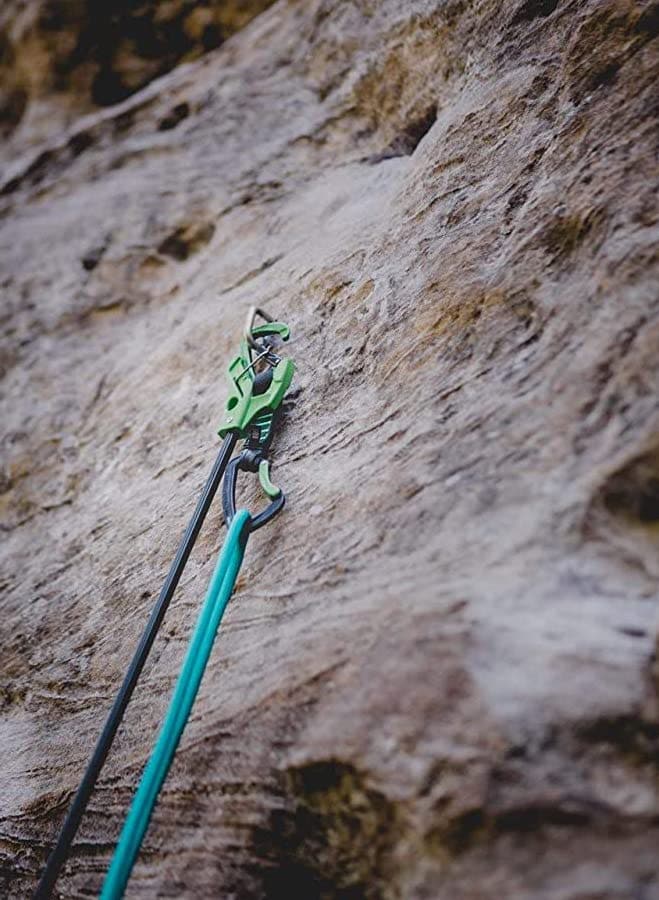
The Ethics of Climbing Booty
The ethics of climbing booty are constantly up for debate and will vary based on your local climbing community’s culture.
However, in most cases (and in my opinion), once you pull your rope and walk away from the climb, the carabiner you left up on the wall becomes fair game– it becomes booty.
Climbing booty, also known as crag swag, is anything you left on the route, including bail biners, stoppers, and camming devices. If the next person who tries the climb succeeds, they get to clean and keep your gear, whether it be a carabiner, a cam, or a full-blown anchor with webbing and trad gear.
Sure, you can ask them to return your gear. Heck, they may even volunteer to give it back– that’d be cool.
But typically, when you bail, you risk losing what you leave behind. This is why bailing off cheap quicklinks or cheap old carabiners exists in the first place– because it’s better to leave behind older biners for the next person than a nice draw.
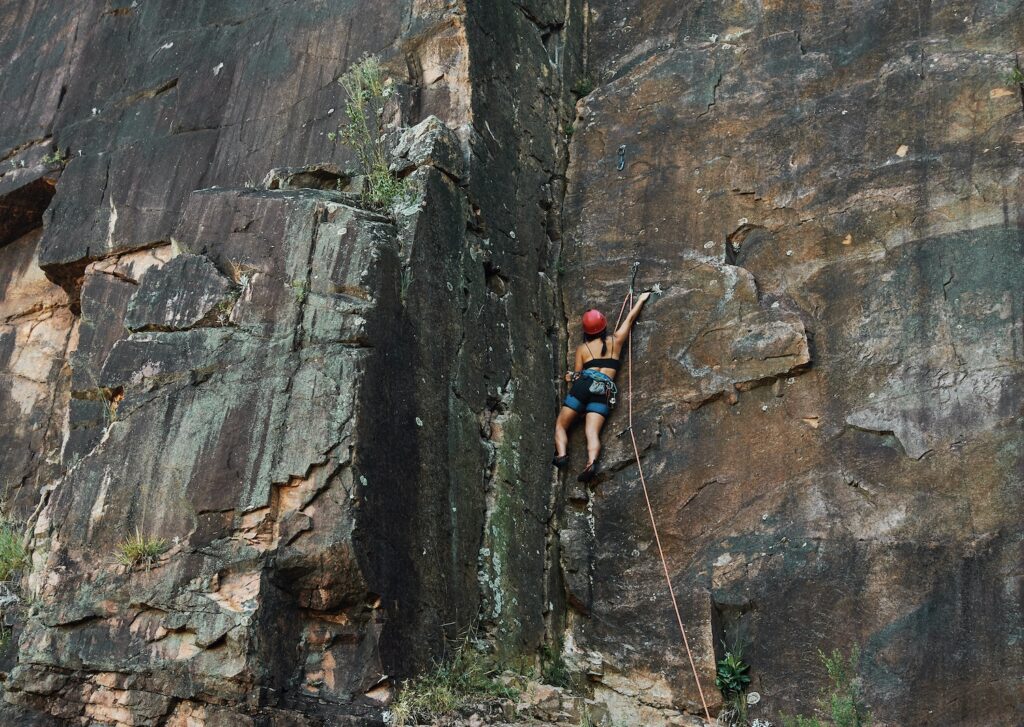
Final Thoughts – Plan Ahead to Avoid Bailing
You are taking a risk every time you go rock climbing. So to mitigate that risk, it’s essential to plan ahead.
For example, wearing a helmet, talking with your belayer about if you want to be lowered or rappel, considering how much daylight you have left, and so on. Part of that planning should be considerations about what you will do if you need to bail, especially if you are climbing near your limit.
Remember– carabiners are cheap, but you are priceless. So do what you must to get down safely and in one piece so you can climb another day.
Have fun, and check your knots!
Frequently Asked Questions (FAQs)
To sum things up – go in-direct, then clip a carabiner beneath the draw. Clip your rope directly into the bail biner and unclip your rope from your quickdraw. Attach a friction hitch. Clean the draw and take off your tether. Then, begin lowering and cleaning the route.
You can use any full-strength climbing carabiner to bail. The easiest option is to use a carabiner from your harness. However, some climbers prefer to carry an old carabiner specifically to bail on a route.
Biner is the shortened slang version of the word “carabiner.”
A bail biner is a carabiner that you use to replace the quickdraw on the last bolt to bail so you can clean your quickdraws and leave nothing behind (except the bail biner).
References
Dangers for climbing ropes
Edelrid, May 2019 (retrieved on 03/27/2023)
https://edelrid.com/us-en/knowledge/knowledge-base/dangers-for-climbing-ropes
Sport climbing: climbing and belaying
Petzl, Access Book #5 (2022) (retrieved on 03/27/2023)
https://s3.amazonaws.com/Petzl_home_Prod/Accessbook/ACCESSBOOK-ROCK-CLIMBING-2022-EN.pdf

